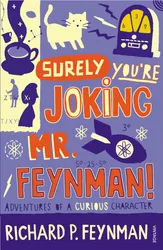Richard Feynman’s name appears a lot in the science books I’ve read so far for this site. He’s regarded as a genius, and has had lots to say about creativity and science in general, as well as being notable for the contributions to physics that won him the Nobel prize. This book is not quite an autobiography. It’s composed of various verbal reminiscences, told to Ralph Leighton, about many of the adventures Feynman had during his career as a physicist. Some of these have to do with physics, and others are in completely different areas. They jump around a little bit, chronologically, although they seem to be roughly in order.
What we learn is that Feynman has a deep curiosity about the world, a knack for getting into adventures, a strong disregard for what other people might think of him, and the willingness to follow his adventures further than I think most people would. His adventures include becoming an “expert” safe cracker at Los Alamos, a celebrated artist who had his own exhibition and sold artworks, and a professional drummer. I particularly loved the safe cracking chapter, because it’s a wonderful mixture of curiosity, willingness to put in effort to practice the techniques, enough bravado to keep his true methods secret, and plenty of dumb luck. His intelligence seems to help him a lot in picking up new skills quickly, and his confidence helps him to get noticed by the people who welcome into their social circles, allowing him to have these adventures.
Although we don’t get to hear all that much about Feynman’s own scientific pursuits, he does have a lot to say about the practice of science throughout the book. At the end is the transcript of a commencement address in which he aims to put across the fundamental principles of science, which he describes as a kind of utter honesty, and a willingness to try to think of everything that could make your test invalid. His ideas about publishing “negative” results as well as positive ones is similar to what was said in Bad Science about medical trials. There is also a section in which he is asked to help select mathematics books for schools, and finds some of the content of these books completely useless.
Most of the adventures happen between the 1940s and 1960s, as far as I can tell. Some of the mindsets and language might seem a little dated to modern sensibilities. The women in this book are portrayed rather one-dimensionally. There are very few women in Feynman’s academic or professional worlds, but this is probably just how things were in those days. Feynman is not shy about expressing his liking for the company of attractive women, and seems to spend a lot of time in bars and clubs, or talking to showgirls in Las Vegas. Other than this, we don’t learn a lot about his personal life. He has 3 wives through the course of the book, but we don’t learn anything about how he met them or what their relationships were like. His wives don’t seem to share any of his adventures with him! We also get to see Feynman’s distrust of authority and bureaucracy. He seems to get away with many things that might not be tolerated nowadays, like taking military secrets from safes. Whether he gets away with things because of his charisma, his intelligence, or just because of the times he was living in, I’m not sure.
The style of writing is quite chatty, as you’d expect from stories that were originally related verbally. This is a really fun book to read. I really enjoyed hearing about all these adventures and the unique approach and attitude of Feynman. Many of the stories are very amusing, and I found myself laughing out loud at some points.
